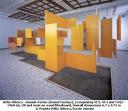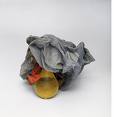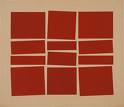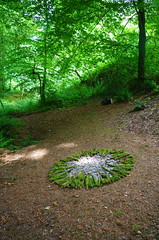Monday – attended a great seminar at Tam’s studios in London this evening, with members of the Landscape & Arts Network (LAN) . Leading the meeting was highly respected Canadian writer, John K. Grande. If you are at all interested in art, nature and culture, his book “Balance: Art and Nature” is one that should not be missed. It is an interesting read, it is clearly and honestly written, and even though it was first published some time ago, it has much to say that is highly relevant to our current ecological predicament.
Tuesday – woke up far too early, to the roar of aeroplanes overhead and traffic down below. I don’t know how London folk can live with this relentless bombardment of noise! But a good chat over Tam’s breakfast table and a few coffees soon brought me to life and put me into a good mood – we set off first to the massive supergallery of Tate Modern, and a small community garden that Tam had played a big part in bringing into being. Tucked just to one side of the Tate, between tower blocks, the garden was surrounded by high security fencing and brick walls. I will leave you to draw your own symbolism from this.
Once inside, my senses were soothed by the scent of wild flowers, a gravel path meandering between flowers, grass and water, and comfortable wooden seats and shelters along the way. Everywhere was full of distraction and delight – poppies and lavender, a pebble labyrinth, bees and butterflies going about their tasks, and goldfish just drifting. How amazing to find all this in such a place! Contact the Landscape & Arts Network if you want to know more about this garden and how it came about.
Into the Tate. Hélio Oiticica – an artist I had never heard of before, and I very much enjoyed following his development – his playful manipulation of colour and perception within a painting, which gradually evolved into large double-sided shapes and sculptural forms, suspended from the ceiling. All designed to entice the visitor to wander amongst free-floating colour fields. A thought of bees and butterflies flitted through my mind, as I idly wondered about their short and ecstatic lives.
Wandering through the sequence of galleries, I enjoyed ever increasing subtle pleasures of colour and light -eventually arriving at a point where the works became three dimensional open box-like forms, some containing raw ground pigment, some with mirrors, and one filled on one side with lumps of coal, and on the other with tiny white  shells. Enticing again, arousing the senses – trying not to touch or taste. Familiar everyday materials began to be incorporated – glass, plastic and painted cloth, which led on to the development of Oiticica’s ‘habitable paintings’: colourful capes tents and banners designed to be worn in what he called ‘body events’.
shells. Enticing again, arousing the senses – trying not to touch or taste. Familiar everyday materials began to be incorporated – glass, plastic and painted cloth, which led on to the development of Oiticica’s ‘habitable paintings’: colourful capes tents and banners designed to be worn in what he called ‘body events’.
By the time I reached the end of the exhibition and its video screening of wild samba dancers, swathed in Oiticica’s capes, I was salivating and alive.

Here is what Oiticica wrote:
The rehearsals themselves are the whole activity, and the participation in it is not really what Westerners would call participation because the people bring inside themselves the “samba fever” as I call it, for I became ill of it too, impregnated completely, and I am sure that from that disease no one recovers, because it is the revelation of mythical activity. . . . Samba sessions all through the night revealed to me that myth is indispensable in life, something more important than intellectual activity or rational thought when these become exaggerated and distorted.
From Artopia: John Perreault’s art diary (an ARTSJOURNAL weblog).
On to the Hayward Gallery, to the Antony Gormley ‘Blind Light’ exhibition.
Gormley’s work focuses on the human body and space. In fact, the first thing one sees on entering the exhibition is what appears to be a massive metal space station… or is it? Like Oiticica, Gormley is disrupting our familiar expectations, only this time, there was no sense of colour, light and joie de vivre – instead I felt a subtle level of fear and fascination. Nothing is quite as it should be – where does the sculpture and the space begin and end? Where do I begin and end? And others? In the Blind Light installation, a room is filled with steam and bright light. People enter and vanish, and emerge again almost like ghosts from another world. Scarey. I had to go in, and once inside, all clues to orientation vanished. I could barely see my hand in front of my face as I stumbled forward hands outstretched, hoping above all that I wouldn’t bump into the owner of one of the disembodied voices I could hear around me. 
Presence or absence? There was a sense of man (and I use the word advisedly, as there seemed to be almost no female element included in the show) dissolving into his  surroundings. Male figures enmeshed in metal structures, which I took to be energy fields or matrices, were almost indistinguishable from their encasement, frozen in time.
surroundings. Male figures enmeshed in metal structures, which I took to be energy fields or matrices, were almost indistinguishable from their encasement, frozen in time.
There was a room full of what looked like automatons made of concrete, human height, all different, but all the same – and with small openings cut through to the interior, reminiscent of WW2 bunkers. Those little openings were everywhere throughout the show – making one feel vulnerable – either spying or spied upon. All together, the crowd of concrete figures resembled a scaled-down cityscape. It was only afterwards, reading the exhibition notes that I found the measurements of each piece had been taken from real individual people in Malmo, and the holes were positioned at the points of ears, mouth, anus and genitals. That spooky near-life experience again! Hoping I wont bump into it.
For me, the exhibition as a whole gave a sense of being lost for eternity in a sinister science fiction universe. Yet paradoxically it made me feel more connected with the space and the physicality of my urban surroundings. And more physically aware of others. And of seeing and being seen. This is a real in-depth human experience, and a masterly and unforgettable exhibition!
If you decide to go along, be sure to go out on to the Hayward’s roof terraces, and look around at the London skyline, where the exhibition continues!
What is the function of art? Do either of these exhibitions point the way forward for humanity in its current ecological crisis? No. And I am not sure that they should. But both certainly awaken the senses, disturb and deepen our perceptions and sensitize us to our inner world and the material world all around. So that can’t be bad. And what about that little community garden hanging on to the Tate’s outskirts? Does that function as art?





